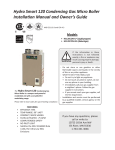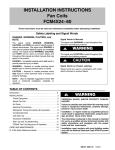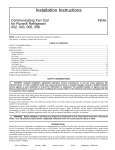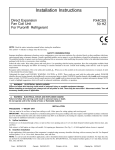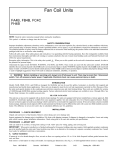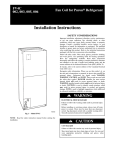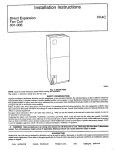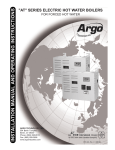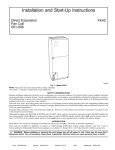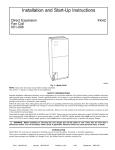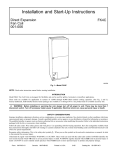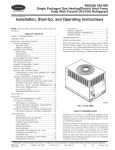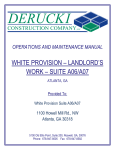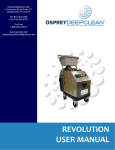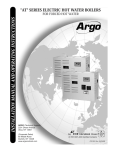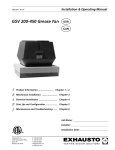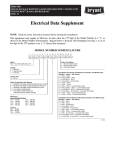Download Installation Manual
Transcript
COMMUNICATING FAN COIL FOR PURONr REFRIGERANT SIZES 002, 003, 004, 005, 006 FE4A FE5A Installation Instructions NOTE: Read the entire instruction manual before starting the installation. PAGE SAFETY CONSIDERATIONS . . . . . . . . . . . . . . . . . . . . . . . . . 1 INTRODUCTION . . . . . . . . . . . . . . . . . . . . . . . . . . . . . . . . . . . 1 INSTALLATION . . . . . . . . . . . . . . . . . . . . . . . . . . . . . . . . . . . . 1 Check Equipment . . . . . . . . . . . . . . . . . . . . . . . . . . . . . . . . 1 severe personal injury or death. WARNING signifies hazards which could result in personal injury or death. CAUTION is used to identify unsafe practices which may result in minor personal injury or product and property damage. NOTE is used to highlight suggestions which will result in enhanced installation, reliability, or operation. ! WARNING Mount Fan Coil . . . . . . . . . . . . . . . . . . . . . . . . . . . . . . . . . . 2 ELECTRICAL OPERATION HAZARD Air Ducts . . . . . . . . . . . . . . . . . . . . . . . . . . . . . . . . . . . . . . . 6 Failure to follow this warning could result in personal injury or death. Electrical Connections . . . . . . . . . . . . . . . . . . . . . . . . . . . . . 6 Refrigerant Tubing Connection & Evacuation . . . . . . . . . . 8 Condensate Drain . . . . . . . . . . . . . . . . . . . . . . . . . . . . . . . . 8 Before installing or servicing unit, always turn off all power to unit. There may be more than 1 disconnect switch. Turn off accessory heater power if applicable. Unit Start--Up . . . . . . . . . . . . . . . . . . . . . . . . . . . . . . . . . . . 9 Accessory Installation . . . . . . . . . . . . . . . . . . . . . . . . . . . . . 9 Start--Up and Troubleshooting . . . . . . . . . . . . . . . . . . . . . 10 FE4A, FE5A Fan Coil Sequence of Operation . . . . . . . . . 13 CARE AND MAINTENANCE . . . . . . . . . . . . . . . . . . . . . . . . 14 PURONR REFRIGERANT QUICK REFERENCE GUIDE . 15 SAFETY CONSIDERATIONS ! WARNING ELECTRICAL OPERATION HAZARD Failure to follow this warning could result in personal injury or death. Consult a qualified installer, service agency, or your distributor or branch for information or assistance. The qualified installer or agency must use factory--authorized kits or accessories when modifying this product. Refer to the individual instructions packaged with kits or accessories when installing. Follow all safety codes. Wear safety glasses and work gloves. Use quenching cloth for brazing operations. Have fire extinguisher available. Read these instructions thoroughly and follow all warnings or cautions attached to the unit. Consult local building codes and National Electrical Code (NEC) for special requirements. . Recognize safety information. This is the safety--alert symbol When you see this symbol on the unit and in instructions manuals, be alert to the potential for personal injury. Understand the signal words DANGER, WARNING, CAUTION, and NOTE. These words are used with the safety--alert symbol. DANGER identifies the most serious hazards which will result in INTRODUCTION Model FE4A, FE5A fan coils are designed to be installed with a communicating User Interface. The FE4A, FE5A fan coils will provide airflow at a rate commanded by the User Interface. The nominal airflow/ton rate is 350 CFM/ton. The User Interface will modify the commanded airflow under certain operating modes. Refer to the User Interface literature for further system control details. This fan coil will not respond to commands from a common thermostat except under certain emergency situations explained in this document. The instructions contained herein provide guidance to successfully install this fan coil. Model FE5A fan coil units are designed for upflow or downflow applications only. Model FE4A fan coil units are designed for flexibility and can be used for upflow, horizontal, or downflow applications. These units are designed specifically for Puronr (R--410A) refrigerant and must be used only with Puronr refrigerant air conditioners and heat pumps as shipped. These units are designed to meet low air leak requirements currently in effect. Because of this, units need special attention in the condensate pan and drain connection area and when brazing tubing. These units are available for application in systems of 18,000 through 60,000 Btuh nominal cooling capacities. Factory--authorized, field--installed electric heater packages are available in 5 through 30 kW. See Product Data for available accessory kits. INSTALLATION Procedure 1 — Check Equipment Unpack unit and move to final location. Remove carton taking care not to damage unit. Inspect equipment for damage prior to installation. File claim with shipping company if shipment is damaged or incomplete. Locate unit rating plate which contains proper installation information. Check rating plate to be sure unit matches job specifications. FE4A / FE5A Procedure 2 — Mount Fan Coil FE5A units can be installed in upflow or downflow positions only. FE4A unit can stand or lie on floor, or hang from ceiling or wall. Allow space for wiring, piping, proper trapping and servicing unit. IMPORTANT: When unit is installed over a finished ceiling and/or living area, building codes may require and it is recommended by the factory, a field--supplied secondary condensate pan to be installed under the entire unit. Some localities may allow the alterative of running a separate, secondary condensate line. Consult local codes for additional restrictions or precautions. FE5A fan coils can be installed for upflow applications as factory shipped. FE4A fan coils can be installed for upflow and horizontal--left applications as factory shipped. (See Figures 1, 2 and 3.) FE4A units can be installed for horizontal--right applications with field modifications. FE4A and FE5A units may be converted for downflow applications using factory--authorized accessory kits. NOTE: To ensure proper drainage for horizontal installations, unit must be installed so it is within 1/8” / 3.18 mm level of the length and width of unit. A. Modular Units The FE4A Fan Coil in size 006 and the FE5A Fan Coil in size 004 are 2--piece modular units. Modular construction allows installer to disassemble unit into 2 components, coil box and blower box, for ease of installation. To disassemble unit, remove rear corner brackets by removing 2 screws which secure brackets. Remove either 2 screws in each front corner of coil box, or 2 screws in blower box. (See Fig. 4.) Do not remove all 4 screws in each corner. Sections may now be separated by lifting top section from lower section. To reassemble, reverse above procedure. Be certain to reinstall all fasteners when reassembling. B. Upflow Installation If return air is to be ducted through a floor, set unit on floor over opening and use 1/8” / 3.18 mm to 1/4” / 6.35 mm thick fireproof resilient gasket between duct, unit, and floor. Side return is a field option on slope coil models. Cut opening per dimensions. (See Fig. 1.) A field--supplied bottom closure is required. All return--air must pass through the coil. C. Horizontal Installations (FE4A Only) Units must not be installed with access panels facing up or down. For applications having high return static and humid return air, the Water Management Kit, accessory part no. KFAHC0125AAA, may be used to assist in the water management. Be sure installation complies with all applicable building codes that may require installation of a secondary condensate pan. 1. Arrange support for unit by setting it in or above secondary condensate pan. 2. When suspending unit from ceiling dimples in casing indicate proper location of screws for mounting metal support straps. (See Fig. 2.) FIELD SUPPLIED SUPPLY DUCT POWER ENTRY OPTIONS LOW VOLT ENTRY OPTIONS 002 - 17.5" (444.5 mm) 003, 004, 005 - 21" (533.4 mm) 006 - 24" (609.6 mm) FRONT SERVICE CLEARANCE A COIL UNITS UPFLOW/DOWNFLOW SECONDARY DRAIN 1 1 ⁄2 ″ (38.1 mm) 19" (482.6 mm) UPFLOW/DOWNFLOW PRIMARY DRAIN FIELD MODIFIED SIDE RETURN 19" (482.6 mm) LOCATION FOR 1 ″ 2 ⁄2 (63.5 mm) 003 UNITS ONLY UPFLOW/DOWNFLOW SECONDARY DRAIN UPFLOW/DOWNFLOW PRIMARY DRAIN FIELD SUPPLIED RETURN PLENUM A07139 Fig. 1 -- Slope Coil Unit in Upflow Application 2 A-COIL HORIZONTAL LEFT SECONDARY DRAIN FIELD SUPPLIED HANGING STRAPS PRIMARY DRAIN 002-005 21" (533.4 mm) 006 24" (609.6 mm) FRONT SERVICE CLEARANCE (FULL FACE OF UNIT) FE4A / FE5A UNIT LOW VOLT ENTRY OPTIONS 1 3/4" (44.45 mm) FILTER ACCESS CLEARANCE PRIMARY DRAIN SECONDARY DRAIN POWER ENTRY OPTIONS A07140 Fig. 2 -- Slope Coil in Horizontal--Left Application (Factory Ready FE4A only) A COIL BRACKET FACTORY SHIPPED HORIZONTAL LEFT APPLICATION COIL SUPPORT RAIL B C DRAIN PAN SUPPORT BRACKET COIL BRACKET HORIZONTAL DRAIN PAN PRIMARY DRAIN HORIZONTAL LEFT AIR SEAL ASSEMBLY REFRIGERANT CONNECTIONS SECONDARY DRAIN HORIZONTAL LEFT A00072 Fig. 3 -- A--Coil in Horizontal--Left Application (Factory Ready FE4A Only) 3 BLOWER BOX 2 SCREWS FE4A / FE5A 2 SCREWS REAR CORNER BRACKET 2 SCREWS COIL BOX A95293 Fig. 4 -- Modular Unit Assembly D. Horizontal--Right Conversion of Units with Slope Coils (FE4A Only) NOTE: Gasket kit number KFAHD0101SLP is required for horizontal slope coil conversion to maintain low air leak/low sweat performance. 1. Remove blower and coil access panels and fitting panel. (See Fig. 5.) 2. Remove screw securing coil assembly to right side casing flange. 3. Remove coil assembly. 4. Lay fan coil on its right side and reinstall coil assembly with condensate pan down. 5. Attach coil to casing flange using previously removed coil mounting screw. 6. Make sure pan cap in fitting door is properly seated on fitting door to retain low air leak rating of the unit. 7. Add gaskets included in kit per kit instructions. 8. Reinstall access panels and fitting panel, aligning holes with tubing connections and condensate pan connections. Make sure liquid and suction tube grommets are in place to prevent air leaks and cabinet sweating. Install grommets after brazing. E. Horizontal Right Conversion of Units With A--Coil (FE4A Only) To convert units for horizontal right installations: 1. Remove blower and coil access panels. (See Fig. 6.) 2. Remove metal clip securing fitting panel to condensate pan. Remove fitting panel. 3. Remove 2 snap--in clips securing A--coil in unit. 4. Slide coil and pan assembly out of unit. 5. Remove horizontal drain pan support bracket from coil support rail on left side of unit and reinstall on coil support rail on right side of unit. 6. Convert air seal assembly for horizontal right. a. Remove air seal assembly from coil by removing 4 screws. b. Remove air splitter (B) from coil seal assembly by removing 3 screws. (See Fig. 6 inset) c. Remove filler plate (A) and install air splitter (B) in place of filler plate. d. Install filler plate (A) as shown in horizontal right application. e. Remove condensate troughs (C) and install on opposite tube sheets. f. Install hose onto plastic spout. 7. Install horizontal pan on right side of coil assembly. 8. Slide coil assembly into casing. Be sure coil bracket on each corner of vertical pan engages coil support rails. 9. Reinstall 2 snap--in clips to correctly position and secure coil assembly in unit. Be sure clip with large offset is used on right side of unit to secure horizontal pan. 10. Remove two oval fitting caps from left side of the coil, access panel, and fitting panel. 11. Remove insulation knockouts on right side of coil access panel. 12. Remove 2 oval coil access panel plugs and reinstall into holes on left side of coil access panel and fitting panel. 13. Install condensate pan fitting caps (from Step 10) in right side of coil door making sure that cap snaps and seats cleanly on back side of the coil door. Make sure no insulation interferes with seating of cap. 14. Reinstall access and fitting panels, aligning holes with tubing connections and condensate pan connections. Be sure to reinstall metal clip between fitting panel and vertical condensate pan. Make sure liquid and suction tube grommets are in place to prevent air leaks and cabinet sweating. 4 COIL MOUNTING SCREW BLOWER ASSEMBLY COIL SUPPORT RAIL DRAINPAN FE4A / FE5A SLOPE COIL SKI PRIMARY DRAIN REFRIGERANT CONNECTIONS SECONDARY DRAIN A03001 Fig. 5 -- Slope Coil in Horizontal--Right Application (FE4A only) A REFRIGERANT CONNECTIONS AIR SEAL ASSEMBLY HORIZONTAL RIGHT APPLICATION COIL SUPPORT RAIL B C COIL BRACKET DRAIN PAN SUPPORT BRACKET COIL SUPPORT RAIL COIL BRACKET HORIZONTAL DRAIN PAN PRIMARY DRAIN HORIZONTAL RIGHT SECONDARY DRAIN HORIZONTAL RIGHT A00071 Fig. 6 -- A--Coil in Horizontal--Right Application (FE4A only) 5 F. Downflow Installations (FE4A and FE5A) ! 4” (101.6 mm) MAX CAUTION SECURE FAN COIL TO STRUCTURE UNIT AWAY FROM WALL PIPE STRAP (TYPICAL BOTH SIDES) PROPERTY DAMAGE HAZARD OR FE4A / FE5A Failure to follow this caution may result in product or property damage. UNIT AGAINST WALL 1/8" (3.18 mm) THICK ANGLE MOUNTING BRACKET (TYPICAL BOTH SIDES) The conversion of the fan coil to downflow requires special procedures for the condensate drains on both A--coil and Slope--units. The vertical drains have an overflow hole between the primary and secondary drain holes. This hole is plugged for all applications except downflow, but must be used for downflow. During conversion process, remove plastic cap covering vertical drains only and discard. Remove plug from overflow hole and discard. At completion of downflow installation, caulk around vertical pan fitting to door joint to retain low air leak performance of the unit. DOWN FLOW BASE KIT (KFACB) In this application, field conversion of the evaporator is required using accessory downflow kit along with an accessory base kit. NOTE: To convert units for downflow applications, refer to Installation Instructions supplied with kit for proper installation. For unit size 003, use kit Part No. KFADC0201SLP. For unit sizes 002, 004, 005, and 006, use kit Part No. KFADC0401ACL. Use fireproof resilient gasket, 1/8-- to 1/4--in. thick, between duct, unit, and floor. NOTE: Gasket kit number KFAHD0101SLP is also required for all downflow applications to maintain low air leak/low sweat performance. G. Manufactured and Mobile Home Housing Applications 1. Fan coil unit must be secured to the structure using field-supplied hardware. 2. Allow a minimum of 24--in. clearance from access panels. 3. Recommended method of securing for typical applications a. If fan coil is away from wall, attach pipe strap to top of fan coil using No. 10 self tapping screws. Angle strap down and away from back of fan coil, remove all slack, and fasten to wall stud of structure using 5/16--in. lag screws. Typical both sides of fan coil. b. If fan coil is against wall, secure fan coil to wall stud using 1/8--in. thick right--angle brackets. Attach brackets to fan coil using No. 10 self tapping screws and to wall stud using 5/16--in. lag screws. (See Fig. 7.) Procedure 3 — Air Ducts Connect supply--air duct over outside of 3/4--in. flange provided on supply--air opening. Secure duct to flange with proper fasteners for type of duct used, and seal duct--to--unit joint. Duct connection flanges are provided on unit air discharge connection. When using FE5A units with 20--kW or FE4A units with 20--, 24--, and 30--kW electric heaters, maintain a 1--in. clearance from combustible materials to discharge plenum and ductwork for a distance of 36” / 914.4 mm from unit. Use accessory downflow base to maintain proper clearance on downflow installations. Use flexible connectors between ductwork and unit to prevent transmission of vibration. When electric heater is installed, use heat resistant material for flexible connector between ductwork and unit at discharge connection. Ductwork passing through unconditioned space must be insulated and covered with vapor barrier. SECURE UNIT TO FLOOR ANGLE BRACKET OR PIPE STRAP 4” (101.6 mm) MAX A07141 Fig. 7 -- Manufactured and Mobile Home Installation Ductwork Acoustical Treatment Metal duct systems that do not have a 90_elbow and 10 ft. of main duct to first branch takeoff may require internal acoustical insulation lining. As an alternative, fibrous ductwork may be used if constructed and installed in accordance with the latest edition of SMACNA construction standard on fibrous glass ducts. Both acoustical lining and fibrous ductwork shall comply with National Fire Protection Association Standards 90A or B as tested by UL Standard 181 for Class 1 air ducts. Procedure 4 — Electrical Connections A. Line--Voltage Connections If unit contains an electric heater, remove and discard power plug from fan coil and connect male plug from heater to female plug from unit wiring harness. (See Electric Heater Installation Instructions.) For units without electric heat: 1. Connect 208/230v power leads from field disconnect to yellow and black stripped leads. 2. Connect ground wire to unit ground lug. Check all factory wiring per unit wiring diagram and inspect factory wiring connections to be sure none were loosened in transit or installation. ! WARNING ELECTRICAL OPERATION HAZARD Failure to follow this warning could result in personal injury or death. Before installing or servicing unit, always turn off all power to unit. There may be more than 1 disconnect switch. Turn off accessory heater power if applicable. 6 WARNING ELECTRICAL SHOCK HAZARD Failure to follow this warning could result in personal injury or death. If a disconnect switch is to be mounted on the unit, select a location where drill or fastener will not contact electrical or refrigerant components. color--coded, insulated (35_C minimum) wires or in accordance with local codes. Connect low--voltage leads to User Interface and outdoor unit. (See Fig. 9 or 10.) NOTE: Where local codes require User Interface wiring be routed through conduit or raceways, splices can be made inside fan coil unit. All wiring must be NEC Class l and must be separated from incoming power leads. WARNING ! Fan Coil User Interface D D C C B B A A Outdoor Air Thermistor (if used) ELECTRICAL SHOCK HAZARD OAT Failure to follow this warning could result in personal injury or death. Field wires on the line side of the disconnect remain live, even when the pull--out is removed. Service and maintenance to incoming wiring can not be performed until the main disconnect switch (remote to the unit) is turned off. CLS Y O Humidifier O Y W W R G R Non-communicating AC / HP C HUM 24vac NOTE: Before proceeding with electrical connections, make certain that supply voltage, frequency, and phase are as specified on unit rating plate. Be sure that electrical service provided by the utility is sufficient to handle the additional load imposed by this equipment. See unit wiring label for proper field high-- and low-voltage wiring. Make all electrical connections in accordance with NEC and any local codes or ordinances that may apply. Use copper wire only. The unit must have a separate branch electric circuit with a field--supplied disconnect switch located within sight from and readily accessible from the unit. A factory--authorized disconnect kit is available for installation of 0-- through 10--kW applications. When electric heat packages with circuit breakers are installed, the circuit breaker can be used as a disconnect. Transformer is factory wired for 230--v operation. For 208--v applications, disconnect black wire from 230--v terminal on transformer and connect it to 208--v terminal. (See Fig. 8.) C C OPN COM Note: O connection for heat pump use only. A07119 Fig. 9 -- Fan Coil Wiring with Non--Communicating Single--Stage AC / HP User Interface Fan Coil Communicating AC / HP D D C C C B B B A A A OAT D Y O C C HUM C 208 COM Humidifier BRN RED 230 CLS OPN 24vac W G R SECONDARY YEL BLK A07120 Fig. 10 -- Fan Coil Wiring Communicating AC/HP PRIMARY A94067 Fig. 8 -- Transformer Connections B. 24--V Control System Connections to Unit Printed--Circuit Board (PCB) Use No. 18 AWG color--coded, insulated (35_C minimum) wires to make low--voltage connections between User Interface and unit. If User Interface is located more than 100 ft. from unit (as measured along the low--voltage wires), use No. 16 AWG C. Manufactured Housing In manufactured housing applications, the Code of Federal Regulations, Title 24, Chapter XX, Part 3280.714 requires that supplemental electric heat be locked out at outdoor temperatures above 40_F (4.4_C), except for a heat pump defrost cycle. The User Interface with an outdoor air temperature sensor can be used to lockout supplemental heat above 40_F (4.4_C) except for heat pump defrost cycle. Refer to User Interface Setup Instructions for how to set “Electric Heat Lockout” temperature. 7 FE4A / FE5A ! NOTE: Outdoor air temperature sensor is factory installed on communicating single-- and two--stage AC and HP units. For non--communicating outdoor units, install the outdoor air temperature sensor shipped with the User Interface. D. Ground Connections ! ! CAUTION PROPERTY DAMAGE HAZARD Failure to follow this caution may result in product or property damage. WARNING Wrap a wet cloth around rear of fitting to prevent damage to TXV and factory made joints. ELECTRICAL OPERATION HAZARD FE4A / FE5A Failure to follow this warning could result in personal injury or death. The cabinet must have an uninterrupted or unbroken ground according to NEC, ANSI/NFPA 70 and local codes to minimize personal injury if an electrical fault should occur. The ground may consist of electrical wire or metal conduit when installed in accordance with existing electrical codes. (See Ground/Conduit Note below.) 4. Evacuate coil and tubing system to 500 microns using deep vacuum method. Procedure 6 — Condensate Drain ! CAUTION PROPERTY DAMAGE HAZARD Failure to follow this caution may result in product or property damage. NOTE: Use UL listed conduit and conduit connector to connect supply wire(s) to unit and obtain proper grounding. If conduit connection uses reducing washers, a separate ground wire must be used. Grounding may also be accomplished by using grounding lug provided in control box. Use of dual or multiple supply circuits will require grounding of each circuit to ground lugs provided on unit and heaters. The conversion of the fan coil to downflow requires special procedures for the condensate drains on both A--coil and Slope--units. The vertical drains have an overflow hole between the primary and secondary drain holes. This hole is plugged for all applications except downflow, but must be used for downflow. During the conversion process, remove the plastic cap covering the vertical drains only and discard. Remove the plug from the overflow hole and discard. At completion of the downflow installation, caulk around the vertical pan fitting to door joint to retain the low air leak performance of the unit. Procedure 5 — Refrigerant Tubing Connection and Evacuation Use accessory tubing package or field--supplied tubing of refrigerant grade. Insulate entire suction tube if field--supplied tubing is used. Tubing package has an insulated suction tube. Do not use damaged, dirty, or contaminated tubing because it may plug refrigerant flow control device. Always evacuate coil and field--supplied tubing to 500 microns before opening outdoor unit service valves. ! CAUTION PROPERTY DAMAGE HAZARD Failure to follow this caution may result in product or property damage. A brazing shield MUST be used when tubing sets are being brazed to the unit connections to prevent damage to the unit surface and condensate pan fitting caps. To connect drains, the cap openings must be removed. Use a knife to start opening near tab and using pliers, pull tab to remove disk. Clean edge of opening if necessary and install the condensate line. Finally, caulk around lines where they exit fitting to retain low leak rating of the unit. Units are equipped with primary and secondary 3/4--in. FPT drain connections. For proper condensate line installation see Figures 1, 2, 3, 5, and 6. To prevent property damage and achieve optimum drainage performance, BOTH primary and secondary drain lines should be installed and include properly sized condensate traps. (See Figures 11 and 12.) Factory--approved condensate traps are available. Be sure to install plastic push--in plugs in unused condensate drain fittings. It is recommended that PVC fittings be used on plastic condensate pan. Do not over--tighten. Finger--tighten plus 1--1/2 turns. Use pipe dope. Units have sweat suction and liquid tube connections. Make suction tube connection first. 1. Cut tubing to correct length. 2. Insert tube into sweat connection on unit until it bottoms. 3. Braze connection using silver bearing or non--silver bearing brazing materials. Do not use solder (materials which melt below 800_F / 427_C). Consult local code requirements. 8 Condensate drain lines should be pitched downward at a minimum of 1” / 25.4 mm for every 10’ / 304.8 cm of length. Consult local codes for additional restrictions or precautions. UNIT ! 2” MIN (51 mm) CAUTION PROPERTY DAMAGE HAZARD Failure to follow this caution may result in product or property damage. 2” MIN (51 mm) Never operate unit without a filter or with filter access door removed. A03002 FE4A / FE5A Fig. 11 -- Recommended Condensate Trap FILTER ACCESS PANEL SECONDARY DRAIN WITH APPROPRIATE TRAP REQUIRED (USE FACTORY KIT OR FIELD--SUPPLIED TRAP) A03013 PRIMARY TRAP REQUIRED (USE FACTORY KIT OR FIELD--SUPPLIED TRAP OF SUFFICIENT DEPTH. STANDARD P--TRAPS ARE NOT SUFFICIENT. SEE FIGURE OF RECOMMENDED CONDENSATE TRAP) Fig. 13 -- Insufficient Condensate Trap A03003 Fig. 12 -- Condensate Trap and Unit ! DO NOT USE SHALLOW RUNNING TRAPS! IMPORTANT: Factory authorized filters must be used when locating the filter inside the unit. (See Table 1.) For those applications where access to an internal filter is impractical, a field--supplied filter must be installed in return duct system. Table 1 – Filter Kits CAUTION FILTER KIT PROPERTY DAMAGE HAZARD Failure to follow this caution may result in product or property damage. Shallow running traps are inadequate and DO NOT allow proper condensate drainage. (See Fig. 13.) NOTE: When connecting condensate drain lines, avoid blocking filter access panel. Prime both primary and secondary condensate traps after connecting to drain pan. NOTE: If unit is located in or above a living space where damage may result from condensate overflow, a field--supplied external condensate pan should be installed underneath entire unit, and a secondary condensate line (with appropriate trap) should be run from unit into the pan. Any condensate in this external condensate pan should be drained to a noticeable place. As an alternative to using an external condensate pan, some localities may allow the use of a separate 3/4--in. condensate line (with appropriate trap) to a place where condensate will be noticeable. The owner of the structure must be informed that when condensate flows from the secondary drain or external condensate pan, the unit requires servicing, or water damage will occur. Install traps in condensate lines as close to the coil as possible. (See Fig. 12.) Make sure that the outlet of each trap is below its connection to the condensate pan to prevent condensate from overflowing drain pan. Prime all traps, test for leaks, and insulate traps if located above a living area. (12 PACK) PART NUMBER KFAFK0212MED KFAFK0312LRG KFAFK0412XXL SIZE USED WITH 002 003, 005 004, 006 Procedure 7 — Unit Start-- Up Refer to outdoor unit Installation Instructions for system start--up instructions and refrigerant charging method details. A. Low--Voltage Circuit Fusing and Reference The low--voltage circuit is fused by a board--mounted 3--amp. automotive fuse placed in series with transformer SEC1 and R circuit. The C circuit of transformer circuit is referenced to chassis ground through a printed circuit run at SEC2 and metal PC board mounting eyelets. Check to be sure PC Board is mounted securely using both factory installed screws. NOTE: Mis--wiring or shorting any of the low voltage connections may cause the low voltage fuse to open but will not damage the User Interface or fan coil control. Simply rewire and replace fuse to correct fault. Procedure 8 — Accessory Installation A. Accessory Electric Heaters Electric heaters may be installed with FE4A, FE5A fan coil per instructions supplied with electric heater package. See unit rating plate for factory--approved electric heater kits. 9 outdoor equipment and will display SYSTEM MALFUNCTION on its screen. Refer to the User Interface Installation Instructions for more detail. See Fig. 14. G. Generator The FE fan coil G thermostat terminal input can be configured through the User Interface to recognize a Generator Normally Open dry--contact output to signal the system that a generator malfunction condition exists. Wire the generator output in series with the R and G thermostat connections at the fan coil control board. The User Interface will display GENERATOR MALFUNCTION when the G thermostat input is energized. This function requires the addition of a Generator Self Test Verifier (Part No. GSV200) which must be purchased separately. Visit www.GeneratorVerifier.com for details and ordering information. Refer to the User Interface Installation Instructions for more detail. See Fig. 14. H. Ventilation Accessory The FE fan coil G thermostat terminal input can be configured through the User Interface to recognize a Normally Open dry--contact output to signal the system that a Ventilation Accessory requires fan coil blower operation. Blower operation can be configured for Low, Med or High speed when the G terminal is energized. Wire the Accessory output in series with the R and G thermostat connections at the fan coil control board. Refer to the User Interface Installation Instructions for more detail. See Fig. 14. HUM C O Y W G R OAT COMM FE4A / FE5A B. Hydronic Heat Applications The FE fan coil supports 2 types of Hydronic Heat applications: 1. Hot water coil in combination with a heat pump, or hot water coil as sole heat source. 2. FE fan coil combined with radiant hot water heat. In either application, Relay Interface Kit, KFAIF0101HWC, must be installed in place of an electric heater. The system will identify that Hydonic Heat has been installed during the initial commissioning process. The system will treat the hot water coil as either auxiliary heat in a heat pump application, or as the sole heat source. Setup options for Hydronic Heat applications are described in the User Interface Installation Instructions. Options include: Hot Water Only Operation, Heat Pump Only Operation, Hot Water Operation during Defrost, Airflow Level Selection, and Blower ON/OFF Delays. C. Outdoor Air Thermistor (OAT) A 2--screw terminal strip is provided for connection of an outdoor temperature thermistor. This strip is marked OAT. The installation of an outdoor temperature sensor using the fan coil OAT terminals is optional. If the outdoor unit is not equipped for communications, fan coil OAT input can be used to supply outdoor temperature data for system level functions and for temperature display on User Interface. Outdoor units with a communicating control are shipped with a factory installed OAT. This factory installed OAT is used for all outdoor unit specific and system level functions requiring outdoor temperature if an OAT is not added to fan coil. If an OAT is added in the fan coil, the fan coil connected OAT will be used for system level functions and the factory supplied outdoor unit OAT will be used for outdoor unit control functions. Using two wires of field--supplied thermostat wire cable, wire one lead of thermistor to one screw terminal and the other lead to remaining screw terminal; there is no polarity to be observed. It is strongly recommended that two wires be used to connect the thermistor to eliminate noise interference in temperature reading. If there are not two spare wires available in cable, one wire may be used to connect thermistor to OAT screw terminal 1 and the other lead of the thermistor can be wired to 24VAC COM (C) wire. OAT screw terminal 1 is terminal located closest to the ABCD system communications and is marked with a small number 1 next to the terminal strip. NOTE: Mis--wiring OAT inputs will not cause damage to either fan coil control or thermistor. If the thermistor is wired incorrectly, no reading will appear at User Interface. Re--wire thermistor correctly for normal operation. D. Electronic Air Cleaner Connections When using an electronic air cleaner with FE4A, FE5A fan coil, use airflow sensor part no. KEAAC0101AAA. The airflow sensor turns on electronic air cleaner when fan coil blower is operating. E. Humidifier Connections The fan coil control terminal marked “HUM” is provided for low voltage (24VAC) control of a humidifier. No humidistat is required as User Interface monitors indoor humidity. When commanded to operate humidifier, the fan coil control will energize the “HUM” output to turn humidifier on and de--energize HUM output to turn humidifier off. Wire “HUM” and “C” terminals directly to humidifier as shown in Fig. 9 or 10. F. System Shutdown Accessories The FE fan coil G thermostat terminal input can be configured through the User Interface to recognize accessories that will shut the system down in response to a malfunction. Types of devices may include a Condensate Overflow Switch that is designed for this purpose. The fan coil can be configured to recognize either Normally Open or Normally Closed (default) contact devices through the User Interface Set--Up screens. Wire the accessory device contacts in series with the R and G thermostat connections at the fan coil control board. The User Interface will respond to the accessory device signal by ordering a shutdown of the indoor and CLS OPN COM System Shutdown Device System Shutdown Device or Generator or VentilationAccessory A07121 Fig. 14 -- “G” Terminal Accessory Wiring Procedure 9 — Start-- Up and Troubleshooting NOTE: Always check high and low voltage supply to the fan coil components. Check the integrity of the plug receptacle connections and fan coil wiring harness prior to assuming a component failure. A. LED Description: LEDs built into fan coil control provide installer or service person information concerning operation and/or fault condition of the fan coil control and ECM motor. This information is also available at system user interface in text with basic troubleshooting instructions. Careful use of information displayed will reduce the need for extensive manual troubleshooting. The amber LED located at bottom center of control adjacent to motor harness plug is motor status LED and it is labeled MOTOR. A second amber LED located in upper right center of control adjacent to System Communications connector (A,B,C,D) is the System Status LED and it is labeled STATUS. The green LED labeled COMM is also located adjacent to System 10 OAT HPT HUM C O Y W G R non--communicating outdoor unit and the R, C, Y, O, W outdoor unit terminal strip connections and will display Status Code 16, System Communication Fault, on amber STATUS LED. No further fan coil troubleshooting information will be available at user interface until communications are re--established. If COMM LED does not light within proper time period and Status Code is not displayed: 1. Check system transformer high and low voltage to be sure the system is powered. 2. Check fuse on fan coil control to be sure it is not blown. If fuse is open, check system wiring before replacing it to be sure a short does not cause a failure of replacement fuse. If COMM LED does not light within proper time period and Status Code is displayed: Check system wiring to be sure user interface is powered and connections are made A to A, B to B, etc. and wiring is not shorted. Mis--wiring or shorting of the ABCD communications wiring will not allow successful communications. NOTE: Shorting or mis--wiring low voltage system wiring will not cause damage to fan coil control or user interface but may cause low voltage fuse to open. C. ECM Motor Troubleshooting The ECM motor used in this product consists of two parts: the Control Module and the motor winding section. Do not assume motor or module is defective if it will not start. Use the designed--in LED information aids and follow troubleshooting steps described below before replacing motor Control Module or entire motor. Motor Control Module is available as a replacement part. VERIFY MOTOR WINDING SECTION: ! WARNING ELECTRICAL SHOCK HAZARD CLS Failure to follow this warning could result in personal injury or possible equipment damage. OPN COM After disconnecting power from the ECM motor, wait at least 5 minutes before removing the control section. Internal capacitors require time to discharge. HEATER MOTOR A07122 Fig. 15 -- Detail of FE4A, FE5A Printed Circuit Board Connections B. Fan Coil Control Start--Up and System Communications Troubleshooting: On power up, green COMM LED will be turned off until successful system communications are established (this should happen within 10 seconds). Once communications with user interface are successful, COMM LED will be lit and held on. At the same time, amber STATUS LED will be lit and held continuously on until a request for operating mode is received. The STATUS LED will be on any time fan coil is in idle mode. If, at any time, communications are not successful for a period exceeding 2 minutes, fan coil control will only allow emergency heating or cooling operation using a common thermostat, a Before proceeding to replace a motor Control Module: 1. Check motor winding section to be sure it is functional. 2. Remove motor Control Module section and unplug winding plug. Motor shaft should turn freely, resistance between any two motor leads should be similar and resistance between any motor lead and unpainted motor end should exceed 100,000 ohms. 3. Failing any of these tests, entire ECM motor must be replaced. 4. Passing all of the tests, motor Control Module alone can be replaced. MOTOR TURNS SLOWLY: 1. Low static pressure loading of blower while access panel is removed will cause blower to run slowly. Particularly at low airflow requests. This is normal, do not assume a fault exists. 2. Recheck airflow and system static pressure using user interface service screens with access panel in place. NOTE: Blower motor faults will not cause a lockout of blower operation. Fan coil control will attempt to run the blower motor as long as user interface maintains a demand for airflow. Fan coil control will not operate electric heaters while a fault condition exists. The fan coil control communicates with the motor at least 11 FE4A / FE5A STATUS SEC-1 COMM SEC-2 FUSE 3AMP Communications connector, below STATUS LED, and is used as an indicator of system communications status. Status Codes will be displayed on the STATUS LED using the following protocol: 1. The number of short flashes indicates first digit of code. 2. The number of long flashes indicates second digit of code. 3. A short flash is 0.25 seconds on. A long flash is 1 second on. 4. The time between flashes is 0.25 seconds. 5. The time between last short flash and first long flash is 1 second. 6. The LED will be off for 2.5 seconds before repeating code. FE4A / FE5A once every 5 seconds, even when the motor is idle. If, during operation, the fan coil control does not communicate with the motor for more than 25 seconds, the motor will shut itself down and wait for communications to be reestablished. D. Using Motor LED in Troubleshooting The MOTOR LED is connected to the blower motor communication line and works with the fan coil control microprocessor and the STATUS LED to provide fan coil operation and troubleshooting information. When the motor is commanded to operate, the MOTOR LED will be turned on and will flash each time instructions are sent to the motor. When the motor is commanded to stop, the MOTOR LED will be turned off. If the MOTOR LED is lit, flashing and the motor is running or if the MOTOR LED is off and the motor is stopped, operation is normal and no motor fault exists. If the MOTOR LED is lit, flashing and the motor does not run, or if the MOTOR LED is off and the motor is running, check the STATUS LED for the Status Code. Refer to the troubleshooting instructions for the indicated Status Code in Section E, Fan Coil Troubleshooting. E. Fan Coil Troubleshooting Fan coil faults indicated by flashing codes on the amber system STATUS LED can be resolved using troubleshooting information provided below. Codes are listed in order of their priority, highest to lowest. Though multiple faults can exist at any time, only the highest priority code will be displayed on STATUS LED. Clearing the indicated fault when multiple faults exist will cause the next highest priority Status Code to be flashed. All existing faults, as well as a fault history, can be viewed at user interface. STATUS CODE 45, CONTROL BOARD TEST FAULT: Fan coil control has failed internal start--up tests and must be replaced. No other service procedure will correct. STATUS CODE 37, HEATER OUTPUT SENSED “ON” WHEN NOT ENERGIZED: Fan coil control is provided with circuitry to detect presence of a 24VAC signal on Electric Heater stage 1 and stage 2 outputs. If fan coil control detects a 24VAC signal on either heater stage output and it is not supplying signal, Status Code 37 will be displayed on STATUS LED. Fan coil control will turn off output and command blower motor to supply an airflow determined to be safe for current operation mode with electric heaters energized. To find the fault: 1. Stop all system operations at User Interface and check heater stage 24VAC outputs. 2. Disconnect electric heater at plug/receptacle 2 and check heater wiring for faults. See Status Code 36 for more information. STATUS CODE 44, MOTOR COMMUNICATION FAULT: The MOTOR LED is connected to the blower motor communication line and works with the fan coil control microprocessor and STATUS LED to provide fan coil operation and troubleshooting information. When motor is commanded to operate, the MOTOR LED will be turned on and will flash each time instructions are sent to the motor. When the motor is commanded to stop, the MOTOR LED will be turned off. The MOTOR LED will not flash to indicate communications when it is turned off. Fan coil control is constantly communicating with the motor, even when the motor and MOTOR LED are off. If motor does not acknowledge receipt of communications, the control will display Status Code 44 on STATUS LED and continue to try to communicate with the motor. If motor acknowledges communication, Status Code will be cleared. If MOTOR LED is lit and flashing and motor does not run: 1. Check the STATUS LED. If STATUS LED is indicating a Status 44 code, check the motor wiring harness for proper connection to control and motor receptacles. 2. Check motor wiring harness to be sure all wiring complies with wiring diagram description, makes a complete circuit from connector to connector and is not shorted. 3. Check 12 Vdc low voltage supply to motor at pins 1 (+) and 2 (--) of motor header connection to fan coil control. If all checks are normal, fan coil control is good and Control Module on motor may need replacement. Check motor and Motor Control Module following the instructions in Section C. ECM Motor Troubleshooting. Shorted or mis--wiring of the low voltage motor harness wiring will not cause damage to fan coil control or to motor Control Module. If the MOTOR LED is off, STATUS LED is indicating a Status Code 44 and motor is running: Disconnect the motor harness at the fan coil control. If motor continues to run, fan coil control is good and Control Module on motor may need replacement. STATUS CODE 25, INVALID MOTOR / MODEL SELECTION: On initial start--up, fan coil control shall poll motor for its size data and check fan coil size data stored in fan coil control memory. 1. If motor size is incorrect for fan coil size or fan coil size data is invalid, Status Code 25 will be displayed on STATUS LED. 2. If model size data is missing (as is the case when a replacement fan coil control is installed), system User Interface will prompt installer to enter correct model size from a list of valid sizes. 3. If motor size is incorrect for model size, motor must be replaced with proper size motor. Fan coil control will not respond to operation requests until this fault condition is resolved. STATUS CODE 27, INVALID OUTDOOR UNIT SIZE: On initial power--up, fan coil control will write into memory outdoor unit size as provided by User Interface in a fully communicating system. 1. If outdoor unit size is invalid, Status Code 27 will be displayed on STATUS LED. 2. User Interface will prompt the installer to choose size from a list of valid sizes for application with fan coil. 3. Check communications wiring to be sure User Interface has established communications with outdoor unit or select proper size from valid size list provided at User Interface. 4. Check motor and motor Control Module following the instructions in Section C. ECM Motor Troubleshooting. STATUS CODE 26, INVALID HEATER SIZE: On initial power--up, fan coil control will write into memory electric heater size as read from heater if heater is provided with Identifier Resistor (IDR). Heater size must be valid for combination of indoor and outdoor components installed. Fan coil control will read IDR value connected to pins 5 and 8 of heater harness connector. If no resistor is found, system User Interface will prompt installer to verify that no heater is installed. Verifying that this is correct will establish that fan coil is operating without an electric heater accessory. Upon choosing negative option, installer will be prompted to select heater size installed from a list of valid heater sizes for fan coil and outdoor unit size installed. If heater ID resistor value read is invalid, Status Code 26 will be displayed on STATUS LED. If heater installed is equipped with a resistor connected to pins 5 and 8 of heater harness connector and Status Code 26 is displayed on STATUS LED: 12 Check system wiring to be sure the User Interface is powered and connections are made A to A, B to B, etc. and wiring is not shorted. Mis--wiring or shorting of the ABCD communications wiring will not allow successful communications. Correcting wiring faults will clear the code and reestablish communications. Shorting or mis--wiring the low voltage system wiring will not cause damage to fan coil control or to User Interface but may cause the low voltage fuse to open. STATUS CODE 46, BROWNOUT CONDITION: If the secondary voltage of the transformer falls below 15VAC for a period exceeding 4 seconds, Status Code 46 will be displayed on STATUS LED. If system includes a non--communicating outdoor air conditioner or heat pump, the User Interface will command the fan coil to turn off Y output controlling compressor. When secondary voltage rises above 17VAC for more than 4 seconds, the brownout condition is cleared and normal system operation will resume subject to any minimum compressor off delay function which may be in effect. Brownout does not affect blower or electric heater operation. STATUS CODE 53, OUTDOOR AIR TEMPERATURE SENSOR FAULT: If an OAT sensor is found at power--up, input is constantly checked to be within a valid temperature range. If sensor is found to be open or shorted at any time after initial validation, Status Code 53 will be displayed at amber STATUS LED. Check for faults in wiring connecting sensor to OAT terminals. Using an Ohmmeter, check resistance of thermistor for a short or open condition. If thermistor is shorted or open, replace it to return the system to normal operation. If fault is in the wiring connections, correcting the fault will clear the code and return the system to normal operation. NOTE: If fault condition is an open thermistor or a wiring problem that appears to be an open thermistor and the power to the fan coil control is cycled off, the fault code will be cleared on the next power--up but the fault will remain and system operation will not be as expected. This is because on power--up, the fan coil control cannot discern the difference between an open sensor or if a sensor is not installed. F. Emergency Heating and Cooling Modes Fan coil control can provide emergency heating or cooling using a common heat/cool thermostat in the event that there are no system communications, fault is in User Interface and no replacement is immediately available. To activate these modes, the thermostat and outdoor unit must be wired as a common heating/cooling system to fan coil control RGWYOC terminals. NOTE: These emergency modes do not provide the level of comfort and efficiency expected by the consumer and should only be activated when User Interface cannot be replaced immediately. Procedure 10 — FE4A, FE5A Fan Coil Sequence of Operation The FE4A, FE5A Fan Coil is designed for installation with a communicating User Interface. This fan coil will not respond to commands provided by a common thermostat except under certain emergency situations described in Procedure 9 -- Start Up and Troubleshooting. The User Interface uses temperature; humidity and other data supplied from indoor and outdoor system components to control heating or cooling system for optimum comfort. The fan coil will be commanded by User Interface to supply airflow and, in the case of a non--communicating outdoor unit, Air Conditioner or Heat Pump control. The fan coil will operate blower at requested airflow for most modes. The nominal requested airflow will be 350 cfm per ton of nominal cooling capacity as defined by outdoor unit size. Actual airflow 13 FE4A / FE5A 1. Check wiring harness connections to be sure connections are secure. 2. If symptoms persist, disconnect wiring harness at fan coil control heater header and check for a resistance value greater than 5000 ohms. 3. Check for proper wiring of resistor assembly. 4. Make sure heater size installed is an approved size for outdoor unit and fan coil sizes installed. NOTE: Fan coil control will not operate electric heater until this Status Code is resolved. If the heater size is set through the User Interface, the heater will be operated as a single stage heater. If staging is desired, the IDR value must be read in by the fan coil control. STATUS CODE 36, HEATER OUTPUT NOT SENSED WHEN ENERGIZED: Fan coil control is provided with circuitry to detect presence of a 24VAC signal on Electric Heater stage 1 and stage 2 outputs. If fan coil control energizes either heater stage and does not detect the 24VAC signal on output, Status Code 36 will be displayed on the STATUS LED Fan coil control will continue to energize heater output(s) and adjust blower operation to a safe airflow level for energized electric heat stage(s). To find the fault: Check for 24VAC on heater stage outputs. Fan coil control or sensing circuit may be bad. NOTE: It may be useful as an electric heater troubleshooting procedure to disconnect the system communications to force Status Code 16 enabling of emergency heat mode. It is difficult to know which heater output is energized or not energized in normal operation. When fan coil is operated in emergency heat mode using electric heaters, both outputs are energized and de--energized together. Terminal strip inputs to control can then be connected R to W to turn on both electric heat outputs. Heater output sensing circuits can then be checked to resolve Status Code 36 or 37 problems. STATUS CODE 41, BLOWER MOTOR FAULT: If MOTOR LED is lit and flashing and motor does not run: 1. Check STATUS LED. If STATUS LED is indicating Status Code 41, motor control has detected that the motor will not come up to speed within 30 seconds of being commanded to run or that the motor has been slowed to below 250 rpm for more than 10 seconds after coming up to speed. Motor wiring harness and fan coil control are operating properly, do not replace. 2. Check to be sure that the blower wheel is not rubbing the housing. 3. Check motor to be sure that the motor shaft is not seized (motor Control Module must be removed and electronics disconnected from windings to perform this check properly). 4. Check motor windings section following instructions in Section C. ECM Motor Troubleshooting. If all these checks are normal, the motor Control Module may need replacement. STATUS CODE 16, SYSTEM COMMUNICATION FAULT: On initial power--up and at any time system communications are not successful for a period exceeding 2 minutes following successful communications, the fan coil control will only allow emergency heating or cooling operation using a common thermostat, a non--communicating outdoor unit, and the RGWYO outdoor unit terminal strip connections and will display Status code 16 on the amber STATUS LED (see section E, Emergency Heating and Cooling Modes). No further fan coil troubleshooting information will be available at the User Interface until communications are reestablished. request will be adjusted from nominal using indoor and outdoor temperature and indoor humidity data to optimize the system operation for occupant comfort and system efficiency. Refer to User Interface literature for further system control details. Airflow during electric heater operation must be greater than a minimum level for safe operation. If User Interface instructs fan coil to turn on electric heat and the requested airflow is less than the minimum value required for safe operation of installed heater, the fan coil control will override requested value with the value shown in Table 2, FE4A, FE5A Fan Coil Airflow Delivery Chart ---- Electric Heating Modes. CARE AND MAINTENANCE FE4A / FE5A For continuing high performance, and to minimize possible equipment failure, it is essential that periodic maintenance be performed on this equipment. The only required maintenance that may be performed by the consumer is filter maintenance. ! The minimum maintenance requirements for this equipment are as follows: 1. Inspect and clean or replace air filter each month or as required. 2. Inspect cooling coil, drain pan, and condensate drain each cooling season for cleanliness. Clean as necessary. An inspection port is provided on all A--coil delta plates. Remove plastic plug to inspect. 3. Inspect blower motor and wheel for cleanliness each heating and cooling season. Clean as necessary. 4. Inspect electrical connections for tightness and controls for proper operation each heating and cooling season. Service as necessary. Consult Fan Coil Service Manual available from equipment distributor for maintenance procedures. ! WARNING CAUTION CUT HAZARD ELECTRICAL SHOCK HAZARD Failure to follow this caution may result in personal injury. Failure to follow this warning could result in personal injury or death. Sheet metal parts may have sharp edges or burrs. Use care and wear appropriate protective clothing and gloves when handling parts. Disconnect all power to unit before servicing field wires or removing control package. The disconnect (when used) on access panel does not disconnect power to the line side of disconnect, but does allow safe service to all other parts of unit. If unit does not have a disconnect, disregard the foregoing. Instead, make sure that a disconnecting means is within sight from, and is readily accessible from, the unit. Disconnect all electrical power to unit before performing any maintenance or service on it. Using the Owner’s/User Manual furnished in outdoor unit, the installing technician should explain system operation to the consumer with particular emphasis on indoor fan coil operation sounds and filter maintenance. Table 2 – FE4A/FE5A Fan Coil Airflow Delivery Chart (CFM) — Electric Heating Models MODEL FE4A OUTDOOR UNIT CAPACITY BTUH ELECTRIC HEATER kW RANGE 5 9 10 15 20 24 30 002 EMERGENCY 18,000 24,000 30,000 36,000 625 625 650 800 975 625 625 725 875 975 675 675 775 875 975 775 — 900 925 1025 950 — — 1125 1125 — — — — — — — — — — 003 EMERGENCY 24,000 30,000 36,000 42,000 675 675 800 975 1125 700 875 875 975 1125 775 875 875 1025 1125 850 1100 1100 1150 1150 1050 1150 1150 1250 1350 — — — — — — — — — — 005 EMERGENCY 30,000 36,000 42,000 48,000 675 800 975 1125 1305 700 875 975 1125 1305 775 875 1025 1125 1305 850 1100 1150 1150 1305 1050 1150 1250 1250 1350 1400 — — — 1500 1425 — — — 1600 006 EMERGENCY 36,000 42,000 48,000 60,000 1050 1050 1125 1300 1625 1050 1050 1125 1300 1625 1050 1100 1150 1300 1625 1050 1350 1350 1350 1625 1125 1350 1350 1500 1750 1750 — — 1750 1750 1750 — — 1750 1750 MODEL FE5A OUTDOOR UNIT CAPACITY BTUH 5 9 10 15 20 24 30 004 EMERGENCY 24,000 30,000 36,000 42000 675 975 1050 1050 1125 775 975 1050 1050 1125 775 975 1100 1100 1150 900 — 1125 1350 1350 1125 — — 1350 1350 — — — — — — — — — — ELECTRIC HEATER kW RANGE Note 1: Emergency --- Air conditioner with electric heater application, or emergency heat. Note 2: These airflows are minimum airflows as UL listed. Note 3: Dashed entry indicates that the heater/fan coil/outdoor unit combination is not approved. Do not apply. 14 PURONR (R--410A) REFRIGERANT QUICK REFERENCE GUIDE Puron refrigerant operates at 50--70 percent higher pressures than R--22. Be sure that servicing equipment and replacement components are designed to operate with Puron refrigerant S Puron refrigerant cylinders are rose colored. S S S Recovery cylinder service pressure rating must be 400 psig, DOT 4BA400 or DOT BW400. Puron refrigerant systems should be charged with liquid refrigerant. Use a commercial type metering device in the manifold hose S Manifold sets should be 700 psig high side and 180 psig low side with 550 psig low--side retard. S Use hoses with 700 psig service pressure rating. S Leak detectors should be designed to detect HFC refrigerant. S Puron refrigerant, as with other HFCs, is only compatible with POE oils. S Vacuum pumps will not remove moisture from oil. S Do not use liquid--line filter driers with rated working pressures less than 600 psig. S Do not leave Puron refrigerant suction line filter driers in line longer than 72 hours. S Do not install a suction--line filter drier in liquid line. S POE oils absorb moisture rapidly. Do not expose oil to atmosphere. S POE oils may cause damage to certain plastics and roofing materials. S Wrap all filter driers and service valves with wet cloth when brazing. S A factory approved liquid--line filter drier is required on every unit. S Do NOT use an R--22 TXV. S If indoor unit is equipped with an R--22 TXV or piston metering device, it must be changed to a hard shutoff Puron refrigerant TXV. S Never open system to atmosphere while it is under a vacuum. S When system must be opened for service, recover refrigerant, evacuate then break vacuum with dry nitrogen and replace filter driers. Evacuate to 500 microns prior to recharging. S Do not vent Puron refrigerant into the atmosphere. S Do not use capillary tube coils. S Observe all warnings, cautions, and bold text. S All indoor coils must be installed with a hard shutoff Puron refrigerant TXV metering device. 15 FE4A / FE5A when charging into suction line with compressor operating FE4A / FE5A Copyright 2007 CAC / BDP D 7310 W. Morris St. D Indianapolis, IN 46231 Printed in U.S.A. Edition Date: 03/07 Manufacturer reserves the right to change, at any time, specifications and designs without notice and without obligations. 16 Catalog No: IM---FE4A ---03 Replaces: IM--FE4A--02
















